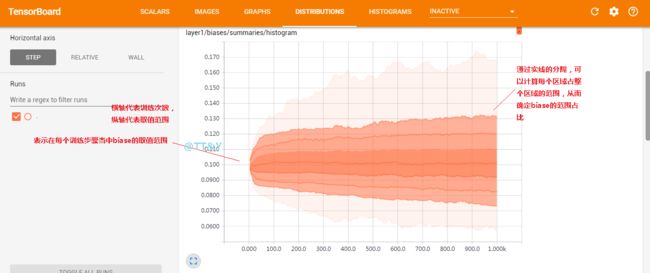本篇博客主要介绍下 tensorboard 的使用方法,tensorboard 是 tensorflow 中一个可视化训练过程中数据的工具,它不需要单独安装,tensorflow 安装过程中已经将其装好了,它可以通过tensorflow程序运行过程中产生的日志文件可视化tensorflow程序的运行状态,它和tensorflow程序跑在不同的进程。下面基于官方的例子源码来讲解 mnist_with_summaries.py
编码阶段
1.添加关心的tensor或者Variable变量到tensorboard中
tf.summary.image 添加需要观察的图片信息
with tf.name_scope('input_reshape'):#使用命名空间,将一些节点信息统一在一起,使计算图看起来整洁
image_shaped_input = tf.reshape(x, [-1, 28, 28, 1])
tf.summary.image('input', image_shaped_input, 10) # 参数:name、tensor、max_outputs
#max_outputs默认是3,我们这里让其多显示几张就写成了10
#使用命名空间后,image的名字类似:input_reshape/input/xxxxx
tf.summary.scalar 添加需要观察的变量信息
# 定义一个对Variable变量(这里有weight和bias)的命名空间公共方法,并计算他们的mean、stddev
# max、min、histogram等值并收集在Tensorboard中供用户查看
def variable_summaries(var):
"""Attach a lot of summaries to a Tensor (for TensorBoard visualization)."""
with tf.name_scope('summaries'):
mean = tf.reduce_mean(var)
tf.summary.scalar('mean', mean) #参数 :name, values
with tf.name_scope('stddev'):
stddev = tf.sqrt(tf.reduce_mean(tf.square(var - mean)))
tf.summary.scalar('stddev', stddev)
tf.summary.scalar('max', tf.reduce_max(var)) #名字类似:xxx/summaries/max
tf.summary.scalar('min', tf.reduce_min(var))
tf.summary.histogram('histogram', var)
tf.summary.histogram 添加对变量或者tensor取值范围的直方图信息
with tf.name_scope('Wx_plus_b'):
preactivate = tf.matmul(input_tensor, weights) + biases
tf.summary.histogram('pre_activations', preactivate) #参数 :name, values
2.汇总所有操作节点,并通过FileWriter创建保存运行过程中信息的文件
tf.summary.merge_all 汇总所有节点操作,并定义两个文件记录器FileWriter
#汇总所有操作,并定义两个文件记录器FileWriter
merged = tf.summary.merge_all()
train_writer = tf.summary.FileWriter(FLAGS.log_dir + '/train', sess.graph) #添加整个计算图
test_writer = tf.summary.FileWriter(FLAGS.log_dir + '/test')
3.训练或者测试过程中运行汇总的节点merged,会产生运行信息并将这些信息写入上一步中创建的文件当中
train_writer.add_summary 往文件中写入信息
#记录训练时运算时间和内存占用情况
run_options = tf.RunOptions(trace_level=tf.RunOptions.FULL_TRACE) #设置trace_level
run_metadata = tf.RunMetadata() #定义tensorflow运行元信息
summary, _ = sess.run([merged, train_step],
feed_dict=feed_dict(True),
options=run_options,
run_metadata=run_metadata)
train_writer.add_run_metadata(run_metadata, 'step%03d' % i)#添加训练元信息
train_writer.add_summary(summary, i)
完整的代码如下:
# coding=UTF-8
import argparse
import os
import sys
import tensorflow as tf
from tensorflow.examples.tutorials.mnist import input_data
FLAGS = None
def train():
# Import data
mnist = input_data.read_data_sets(FLAGS.data_dir,
fake_data=FLAGS.fake_data)
# 默认的session,可以先构建session后定义操作,如果使用tf.Session()需要在启动session之前构建整个计算图,
# 然后启动该计算图。它还可以直接在不声明session的条件下直接使用run(),eval()
sess = tf.InteractiveSession()
# Create a multilayer model.
# Input placeholders
with tf.name_scope('input'): #使用命名空间,将一些节点信息统一在一起,使计算图看起来整洁
x = tf.placeholder(tf.float32, [None, 784], name='x-input')
y_ = tf.placeholder(tf.int64, [None], name='y-input')
with tf.name_scope('input_reshape'):
image_shaped_input = tf.reshape(x, [-1, 28, 28, 1])
tf.summary.image('input', image_shaped_input, 10) #使用命名空间后,image的名字类似:input_reshape/input/xxxxx
# We can't initialize these variables to 0 - the network will get stuck.
#模型参数初始化
def weight_variable(shape):
"""Create a weight variable with appropriate initialization."""
initial = tf.truncated_normal(shape, stddev=0.1)
return tf.Variable(initial)
def bias_variable(shape):
"""Create a bias variable with appropriate initialization."""
initial = tf.constant(0.1, shape=shape)
return tf.Variable(initial)
# 定义一个对Variable变量(这里有weight和bias)的命名空间公共方法,并计算他们的mean、stddev
# max、min、histogram等值并收集在Tensorboard中供用户查看
def variable_summaries(var):
"""Attach a lot of summaries to a Tensor (for TensorBoard visualization)."""
with tf.name_scope('summaries'):
mean = tf.reduce_mean(var)
tf.summary.scalar('mean', mean)
with tf.name_scope('stddev'):
stddev = tf.sqrt(tf.reduce_mean(tf.square(var - mean)))
tf.summary.scalar('stddev', stddev)
tf.summary.scalar('max', tf.reduce_max(var)) #名字类似:xxx/summaries/max
tf.summary.scalar('min', tf.reduce_min(var))
tf.summary.histogram('histogram', var)
def nn_layer(input_tensor, input_dim, output_dim, layer_name, act=tf.nn.relu):
"""Reusable code for making a simple neural net layer.
It does a matrix multiply, bias add, and then uses ReLU to nonlinearize.
It also sets up name scoping so that the resultant graph is easy to read,
and adds a number of summary ops.
"""
# 定义一个MLP多层神经网络来训练数据,包括:初始化weight和bias、做一个矩阵相乘再加上一个偏置项,然后经过一个非线性
#激活函数
# Adding a name scope ensures logical grouping of the layers in the graph.
with tf.name_scope(layer_name):
# This Variable will hold the state of the weights for the layer
with tf.name_scope('weights'):
weights = weight_variable([input_dim, output_dim])
variable_summaries(weights)
with tf.name_scope('biases'):
biases = bias_variable([output_dim])
variable_summaries(biases)
with tf.name_scope('Wx_plus_b'):
preactivate = tf.matmul(input_tensor, weights) + biases
tf.summary.histogram('pre_activations', preactivate)
activations = act(preactivate, name='activation')
tf.summary.histogram('activations', activations)
return activations
hidden1 = nn_layer(x, 784, 500, 'layer1') #使用前面定义的网络
#使用dropout
with tf.name_scope('dropout'):
keep_prob = tf.placeholder(tf.float32)
tf.summary.scalar('dropout_keep_probability', keep_prob)
dropped = tf.nn.dropout(hidden1, keep_prob)
# Do not apply softmax activation yet, see below.
# 这里激活函数用的是全等映射,即直接将输入复制给输出
y = nn_layer(dropped, 500, 10, 'layer2', act=tf.identity)
with tf.name_scope('cross_entropy'):
# The raw formulation of cross-entropy,
# tf.reduce_mean(-tf.reduce_sum(y_ * tf.log(tf.softmax(y)), reduction_indices=[1]))
# can be numerically unstable.
# So here we use tf.losses.sparse_softmax_cross_entropy on the
# raw logit outputs of the nn_layer above, and then average across
# the batch.
with tf.name_scope('total'):
#计算softmax和交叉熵
cross_entropy = tf.losses.sparse_softmax_cross_entropy(
labels=y_, logits=y)
tf.summary.scalar('cross_entropy', cross_entropy)
#使用Adam优化器对损失进行优化
with tf.name_scope('train'):
train_step = tf.train.AdamOptimizer(FLAGS.learning_rate).minimize(
cross_entropy)
#统计正确率
with tf.name_scope('accuracy'):
with tf.name_scope('correct_prediction'):
correct_prediction = tf.equal(tf.argmax(y, 1), y_)
with tf.name_scope('accuracy'):
accuracy = tf.reduce_mean(tf.cast(correct_prediction, tf.float32))
tf.summary.scalar('accuracy', accuracy)
# Merge all the summaries and write them out to
# ./logs/(by default)
#汇总所有操作,并定义两个文件记录器FileWriter
merged = tf.summary.merge_all()
train_writer = tf.summary.FileWriter(FLAGS.log_dir + '/train', sess.graph)
test_writer = tf.summary.FileWriter(FLAGS.log_dir + '/test')
tf.global_variables_initializer().run()
# Train the model, and also write summaries.
# Every 10th step, measure test-set accuracy, and write test summaries
# All other steps, run train_step on training data, & add training summaries
#定义一个feed_dict函数来确定要训练数据还是测试数据
def feed_dict(train):
"""Make a TensorFlow feed_dict: maps data onto Tensor placeholders."""
if train or FLAGS.fake_data:
xs, ys = mnist.train.next_batch(100, fake_data=FLAGS.fake_data)
k = FLAGS.dropout
else:
xs, ys = mnist.test.images, mnist.test.labels
k = 1.0
return {x: xs, y_: ys, keep_prob: k}
for i in range(FLAGS.max_steps):
if i % 10 == 0: # Record summaries and test-set accuracy
summary, acc = sess.run([merged, accuracy], feed_dict=feed_dict(False))
test_writer.add_summary(summary, i)
print('Accuracy at step %s: %s' % (i, acc))
else: # Record train set summaries, and train
if i % 100 == 99: # Record execution stats
#记录训练时运算时间和内存占用情况
run_options = tf.RunOptions(trace_level=tf.RunOptions.FULL_TRACE)
run_metadata = tf.RunMetadata()
summary, _ = sess.run([merged, train_step],
feed_dict=feed_dict(True),
options=run_options,
run_metadata=run_metadata)
train_writer.add_run_metadata(run_metadata, 'step%03d' % i)#添加训练元信息
train_writer.add_summary(summary, i)
print('Adding run metadata for', i)
else: # Record a summary
summary, _ = sess.run([merged, train_step], feed_dict=feed_dict(True))
train_writer.add_summary(summary, i)
train_writer.close() #记得关闭
test_writer.close()
def main(_):
if tf.gfile.Exists(FLAGS.log_dir):#文件存在就删除,重新训练生成
tf.gfile.DeleteRecursively(FLAGS.log_dir)
tf.gfile.MakeDirs(FLAGS.log_dir)
train()
if __name__ == '__main__':
parser = argparse.ArgumentParser() #命令行参数解析,没有默认值就提示用户输入
parser.add_argument('--fake_data', nargs='?', const=True, type=bool,
default=False,
help='If true, uses fake data for unit testing.')
parser.add_argument('--max_steps', type=int, default=1000,
help='Number of steps to run trainer.')
parser.add_argument('--learning_rate', type=float, default=0.001,
help='Initial learning rate')
parser.add_argument('--dropout', type=float, default=0.9,
help='Keep probability for training dropout.')
parser.add_argument(
'--data_dir',
type=str,
default="./mnist_data",
help='Directory for storing input data')
parser.add_argument(
'--log_dir',
type=str,
default="./logs",
help='Summaries log directory')
FLAGS, unparsed = parser.parse_known_args()
tf.app.run(main=main, argv=[sys.argv[0]] + unparsed)
TensorBoard 可视化文件生成
上面代码运行完成后会在train_writer和test_writer指定目录下生成类似"events.out.tfevents.1513910245.N22411D1"这种的文件,然后通过命令行输入命令
tensorboard --logdir=path/to/log-directory #注意这里只需要指定到生成文件的上一级目录就可以了
会有如下提示:
F:\>tensorboard --logdir=./log
TensorBoard 0.4.0rc3 at http://N22411D1:6006 (Press CTRL+C to quit)
最后我们通过将" http://N22411D1:6006"输入谷歌或者火狐浏览器就可以了。
TensorBoard 可视化文件分析
请放大查看原图,图中有注释说明。
SCALARS
统计一些准确率、损失函数、weight等单个值的变化趋势
IMAGES
显示你指定的一些图片信息
GRAPHS
显示你定义的整个计算图,包括计算图里面每个节点的详细信息,比如输入输出的shape是多少,内存占用,计算时间占用,节点名称等等
DISTRIBUTIONS
显示你指定的一些模型参数随着迭代次数增加的变化趋势
HISTOGRAMS
显示你指定的一些模型参数随着迭代次数增加的变化趋势
参考:《TensorFlow实战》




